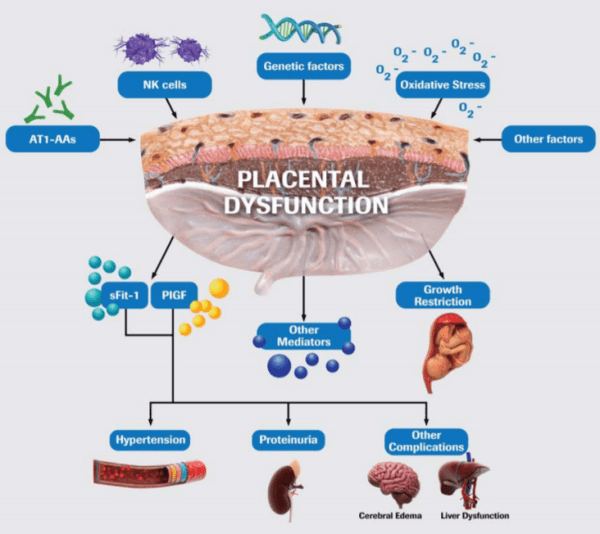
An innovative approach to accurately detect and predict a woman’s risk of preeclampsia
Dr Yi-Ning Su is the Chairman and Chief Executive Officer of Sofiva Genomics Ltd and Dianthus MFM Clinic, based in Taiwan. He is a leading obstetrician and a clinical geneticist specialising in prenatal diagnosis and genetic testing. A pioneer in the field of maternal-fetal medicine, Dr Su was the first in Taiwan to publish a paper on the correlation between preeclampsia and a protein called Placental Growth Factor, or PlGF.1 This led to a new era in preeclampsia screening in Taiwan, safeguarding millions of women by accurately diagnosing their risk. In this interview with Diagram magazine, Dr Su discusses an innovative new approach for the triage of women suspected of developing this pregnancy-related complication.
Dr Yi-Ning Su’s interest in maternal health dates back to his days as a PhD student at the National Taiwan University. One of his projects was on preeclampsia, and it left a lasting impression on the young student.
Back then preeclampsia was seen as a condition that, in Dr Su’s words,“remained unsolved”. Not much was understood about its causes or screening methods. While the medical community was aware of PIGF, not many knew about the soluble fms-like tyrosine kinase-1 (sFlt-1), which meant doctors weren’t on the lookout for altered sFlt-1 levels.
In the absence of any clinical evidence, there was no national program to screen pregnant women for preeclampsia. But Dr Su’s clinical paper showed that the use of PAPP-A, PlGF and Uterine Artery Resistance, could detect preeclampsia in the early trimester.
This became a career defining moment for Dr Su. “Before this, there was a lot of guesswork. We had no sure shot way of identifying whether or not an expectant mother was showing signs of preeclampsia.”
Putting millions of women at risk of preeclampsia
A serious pregnancy complication, preeclampsia is characterised by the onset of hypertension and proteinuria (protein in the urine). But detecting it is not easy. Nicknamed “the great imitator”, preeclampsia often mimics symptoms of many typical pregnancies, such as nausea, lower back pain, weight gain and swelling of the limbs.
When left undetected or untreated, the condition can lead to serious complications for both mother and baby. Women may suffer from stroke, seizures, organ failure, and in some cases it can lead to death. For babies, complications include slower growth inside the uterus and low birth weight.
Preeclampsia is responsible for around 15% of all premature births2 and 42% of maternal deaths3 worldwide. Women with a history of preeclampsia also have an increased risk of dyslipidaemia, hypertension and cardiovascular and renal disease.
In the context of Taiwan, he says, “There is definitely a rising trend of preeclampsia among women. The risk for preeclampsia increases with age and we’re seeing more women having children later in life. So I would say overall about 5% have a high risk of developing preeclampsia and for 2% it will be very severe.”
Although the precise pathophysiology of preeclampsia remains unknown, the sFlt-1 and PlGF biomarkers have the potential to offer major advances in the diagnosis and management of this common and potentially life-threatening condition, according to Dr Su.
Currently, the worldwide medical gold standard for diagnosing and predicting preeclampsia is the combination of high blood pressure and proteinuria. Both are considered poor predictors for which women will develop preeclampsia and how the disease will progress.4 Furthermore, many women with preeclampsia experience no symptoms at all. As a result, healthcare providers spend an estimated US $120 billion every year treating preeclampsia.5
The value of predictive diagnosis

Discussing the challenges in diagnosing and predicting preeclampsia, Dr Su said, “The clinical presentation of preeclampsia and subsequent clinical course of the disease can vary tremendously, making diagnosis and assessment of disease progression difficult. But now, precise diagnostic tools can help us to predict which pregnant women with suspected preeclampsia will and will not develop the condition with greater certainty than standard diagnostics.”
Dr Su advocates the use of advanced screening tests to accurately detect and predict a woman’s risk of preeclampsia by measuring the ratio between two proteins found in the mother’s blood – sFlt-1 and PlGF. “Such tests give us the ability to rule in or out the likelihood of preeclampsia. We can be confident that expectant mothers who do not show abnormal levels are unlikely to develop preeclampsia. And for the ones that do, we can take adequate steps to monitor and treat the condition.”
This has enormous economic benefits too. A study in the United Kingdom showed that the use of the sFlt-1 and PlGF preeclampsia tests could reduce hospitalisation by 50%6 and save the National Health Service around £28 million every year.6 With such advancements, Dr Su concludes,
“What’s important now is deepening scientific understanding among healthcare professionals so that the expectant mother can focus on what really matters – her health and that of her unborn child.”
References:
¹ Su YN, et al. 2001. Obstet Gynecol. Jun;97(6):898-904.
² Goldenburg, R.L., Rouse, D.J. 1998. NEJM 339:313-320.
³ Verlohren, S., et al. 2010. Am J Obstet Gynecol 202 (161): e1-11.
⁴ Verlohren, S., Stepan, H., & Dechend, R. 2012. Clin Sci 122(2): 43-52.
⁵ Meads, C.A., Cnossen, J.S., Meher, S., et al. 2008. Health Technol Assess. 12(6), iii-iv. Methods of prediction and prevention of preeclampsia: systematic reviews of accuracy and effectiveness literature with economic modelling.
⁶ Strunz-McKendry et al. 2014. 20th COGI World Congress 2014.
Infographic References:
¹Levine et al. 2004. N Engl J Med.
²Wang et al. 2009. Physiology.














